:::
:::
:::
Surrealism and eroticism
From The Art and Popular Culture Encyclopedia
In the mid 20th century, surrealism offered new modes of representation of the nude. For surrealist artists, the erotic became a way of exploring ideas of fantasy, the unconscious and the dream state. Artists such as Paul Delvaux, Giorgio de Chirico and Max Ernst are well known surrealist artists that dealt with the erotic directly.
| Contents 1 Desire Unbound 2 Sade’s influence on Surrealism 3 Investigating Sex: Surrealist Discussions 1928-1932 4 L’Érotique du surréalisme 5 Surréalisme et sexualité |
“Eroticism was the theme of a major surrealist exhibition held in 1959. Designed by Breton and Marcel Duchamp, it was arranged as a journey through a series of feminine spaces. Visitors entered the gallery through a ‘love grotto’, a dark cavernous tunnel that led to a rose-coloured chamber where the ceiling seemed to breathe in and out. The recording of women’s orgasmic sighs, made specially for that exhibition and not heard publicly since, is played in this space.” [1]
See also
- Man Ray‘s erotic photography, most famously Printemps, Eté, Automne, Hiver
- Marcel Duchamp‘s Please Touch
- Surrealism
- Eroticism
- Desire Unbound
- Sade’s influence on Surrealism
- L’Érotique du surréalisme
- Surréalisme et sexualité
- 20th century erotica
:::
Surrealist Erotica: In Memory of Nusch Eluard
:::
The Phantasmagoric Allure of Leonor Fini
by Adnan Qiblawi – Artnet
On the 100th anniversary of Surrealism, Leonor Fini, the Surrealist woman artist, is finally getting the recognition she deserves. But by her own measure, Fini was neither a Surrealist, nor was she even a woman artist.
“She wanted to identify as an independent artist,” said the Parisian gallerist Arlette Souhami. “’I am an artist,’ she would say. ‘Not a woman artist, not a man artist, but an artist.’ She refused to show in exhibitions composed of female artists. She hated extremists of any kind. She did not want to be associated with any specific group, be they women, or Surrealists, or whomever else.” Souhami was Fini’s friend and art dealer of almost 20 years and attributes her underappreciation by the art world to her insistence on nonalignment.
“Leonor was highly intelligent,” she said, “but very difficult.”
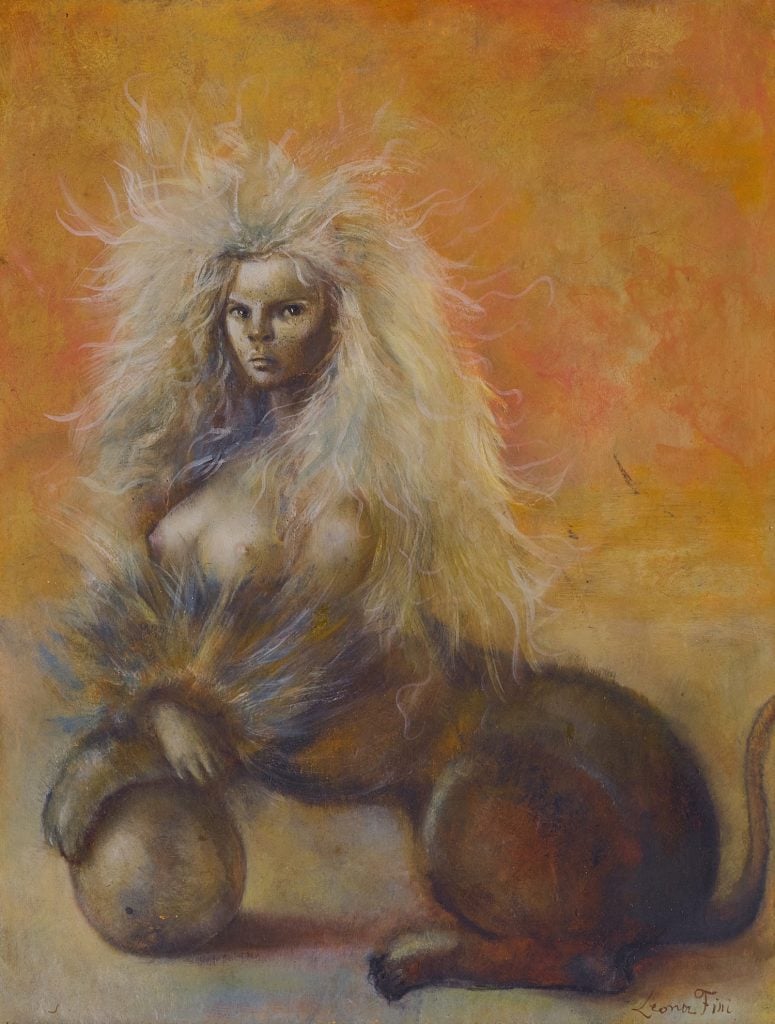
Leonor Fini, Sphinx pour David Barrett (1954). Image courtesy of Sotheby’s.
Fini (1907-1996) eschewed categorization. She delved into the natural and the supernatural through a multi-disciplinary practice (through the lens of an haute-couture witch). Her diverse career spanned 70 years. She marked her artworld debut at the age of 22 with her first solo exhibition in Milan in 1929. Yet, the sensual mythologies she explored in her Surrealist paintings are resonating today more than ever.
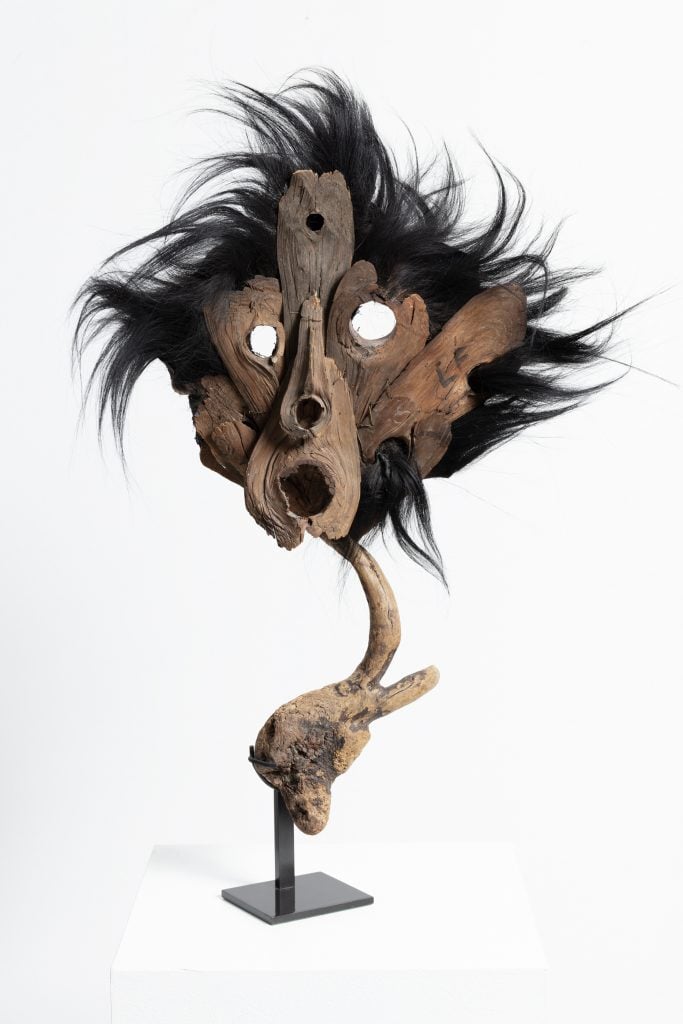
Leonor Fini, M5 Black Scarecrow mask, c. 1960, black thick felt fabric and driftwood tree branch (found in Corsica). Courtesy of Galerie Minsky and Kasmin, New York.
Fini was featured in the 2022 Venice Biennale, which headlined female surrealists, but didn’t get as much of a profile boost compared to her comrade Leonora Carrington, who coined the exhibition title, “The Milk of Dreams.” Kasmin gallery hosted “Metamorphosis,” a revelatory solo exhibition last year that combined Fini’s paintings, drawings, sculpture, and costumes, further exposing the audiences to her phantasmagorical allure. Kasmin’s president Nick Olney believes the surge of renewed interest in her work will continue.
“Leonor has been under-seen in the U.S for many years,” he said. “Her work is so multifarious and strong. So much of the dominant conversation of the second half of the 20th century was steering towards aesthetic and conceptual purity, by not treating art that had elements of emotion or magic as serious contemporary work. There is a greater openness now to that kind of power in art, and to truly multidisciplinary artists.”
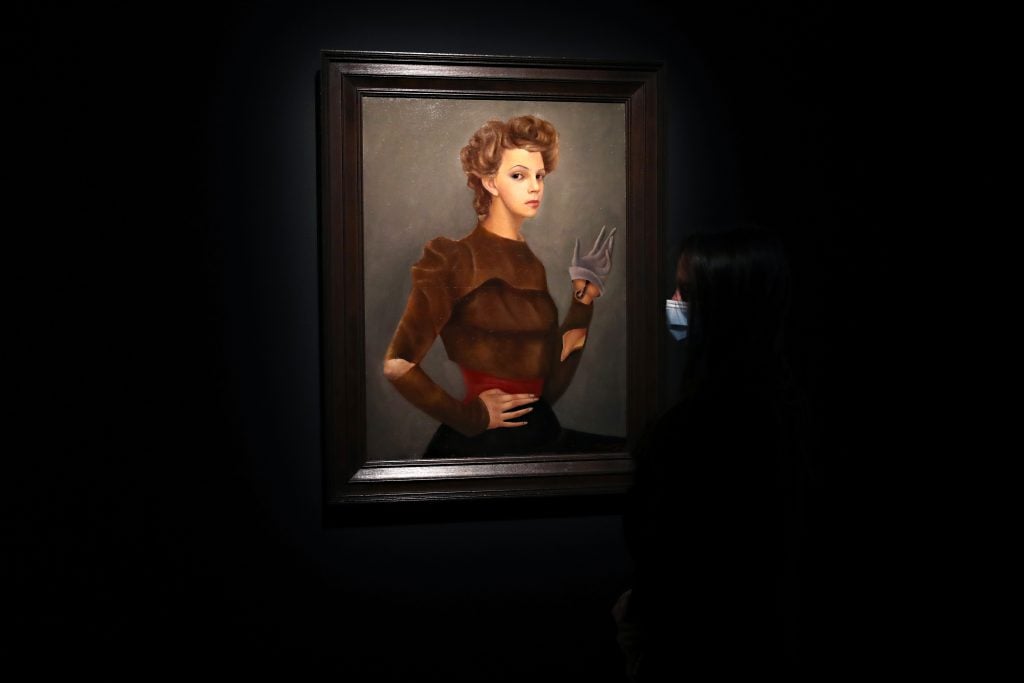
Leonor Fini, Autoportrait au scorpion on display during Sotheby’s NY press preview of the Impressionist and Modern Art Evening Sale at Sotheby’s on May 03, 2021 in New York City. (Photo by Cindy Ord/Getty Images)
Fini reached a market high in 2021 when her austere self-portrait showing a scorpion emerging from her dainty glove sold for three times its estimate at Sotheby’s for $2.3 million. She now has a painting on display at Imagine!, the centennial review of surrealist art at the Royal Museum of Fine Arts in Belgium opening this week.
A prime articulation of her surrealist oeuvre is Chthonian Deity Watching over the Sleep of a Young Man (1946). A shadow-black sphinx, Fini’s signature avatar and vessel for feminine divinity, looms over a slumbering man, her gaze downcast at his supple body, naked except for a swath of pink fabric. An expression on the demigoddess’s face suggests she is contemplating her ward’s beauty—or, rather, considering swallowing him whole. The exposed boy does not appear entirely unaware of his likely fate. Perhaps he invites it? The depiction is a role reversal of the period’s sexual dynamics – here, man is muse and snack, woman holds power.
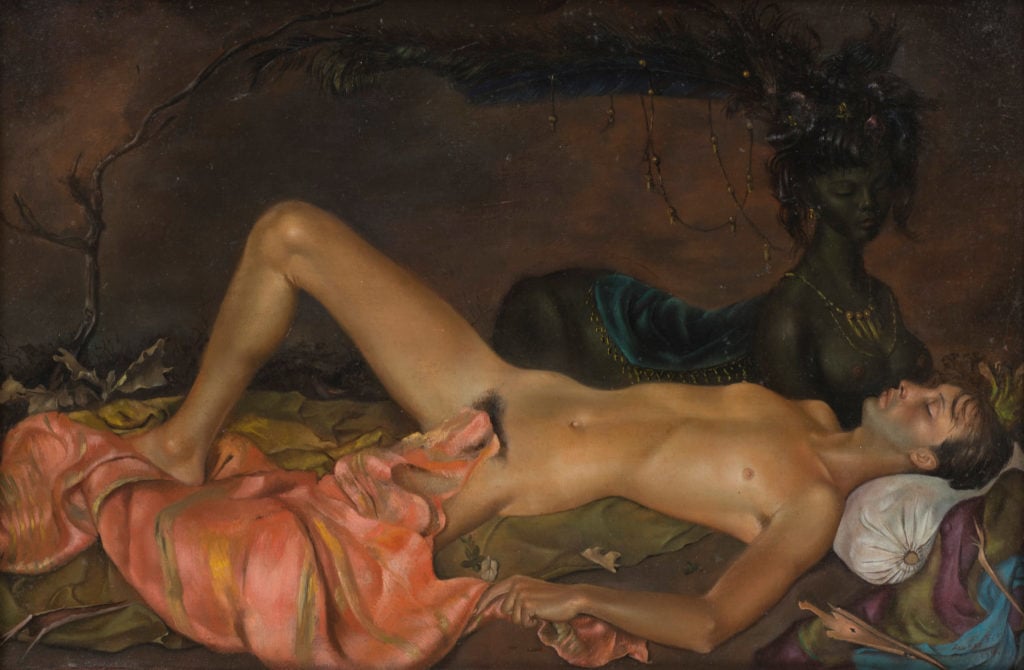
Leonor Fini, Chtonian Deity Watching over the Sleep of a Young Man (1946). © Weinstein Gallery, San Francisco and Francis Naumann Gallery, New York / VG Bild-Kunst, Bonn 2020
Despite her growing popularity as a self-taught artist, her relationship with Surrealism was complicated. Surrealism coalesced in 1924 when a band of male European artists united to sign the Surrealist Manifesto. Fini became acquainted with the movement’s members around a decade later once they took interest in her work. On their very first meeting, Fini arrived at the café rendezvous dressed in the scarlet robes of a Catholic cardinal. She said she wanted to know how it felt to wear the clothes of a man who would never know a woman’s body. She became an overnight sensation.
Her biographer Desmond Morris, considers Fini an “antagonistic surrealist” – an artist who produced surrealist work while polemically rejecting the official movement’s leader, André Breton, along with his ideals. Fini refused to sign the group’s charters, repulsed by Breton’s authoritarianism as well as the very notion of treatises and manifestos, which she viewed as symptomatic of a “petit bourgeois” mentality.
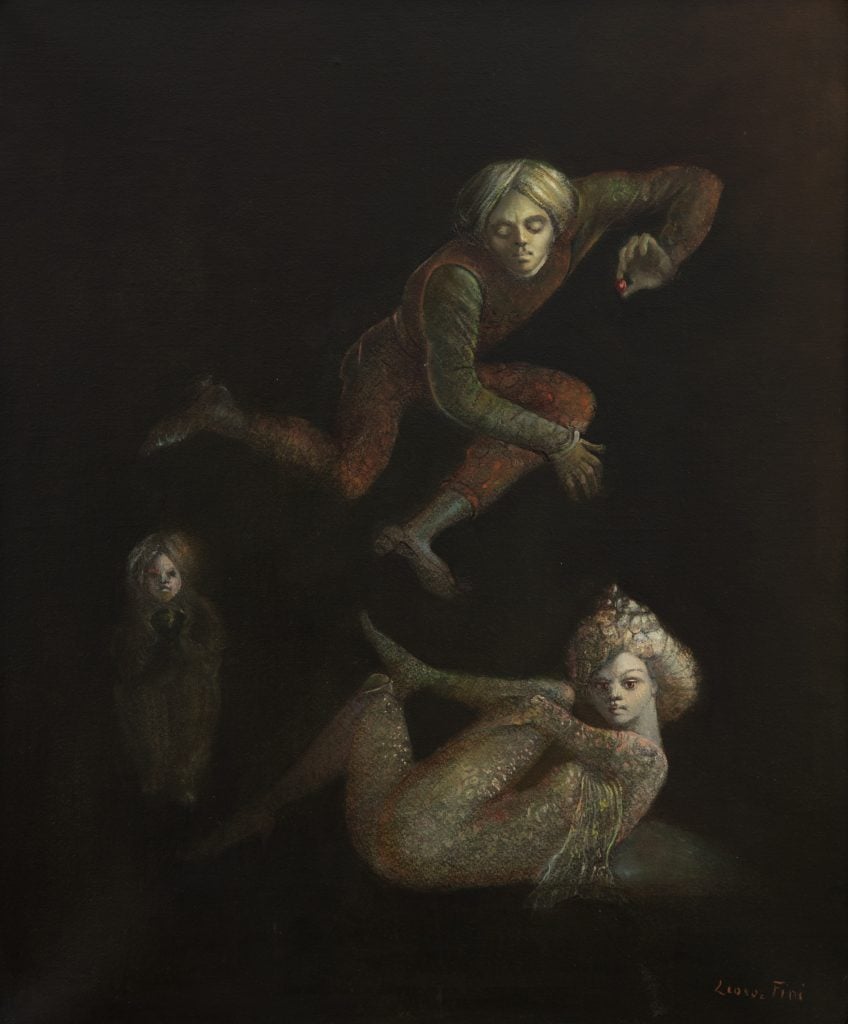
Leonor Fini, Mise en garde ( ̈Petites enseignes pour la Nuit VI), 1982. Courtesy of Galerie Minsky and Kasmin, New York.
Even as an independent, she remained friends with many of Paris’s great artists. French poet Jean Genet was one of them. In his first foray into art criticism, he published a letter to Fini accusing the painter of withholding. “You seem to me on the edge of metamorphosis,” he wrote. “Stop the game of appearances: appear.” He elaborated that following his advice might make her “worthy of being presented in that tiny room in the Louvre where they hang two portraits by Dürer.”
Though Fini’s art explored the erotic with an occult fascination, toying with the immemorial power struggle of the feminine versus the masculine, she categorically rejected the idea that she should be admired or appreciated as a woman artist. “They harass me like flies,” she said, “I find all these feminists grotesque.”

Leonor Fini, Hero et Léandre,1968. Courtesy of Galerie Minsky and Kasmin, New York.
The night they met in 1978, Souhami says Fini turned to her and said “I warn you, you’re cute, but I do not like women.” Souhami retorted “Well neither do I.” She describes the artist as highly feminine, and formidably free, living in a long-term polyamorous relationship with her two male lovers and her 23 cats. The felines were known to have full access to dinner-party tables, winding between guests and partaking of the food. Guests never dared to shoo one away, afraid of incurring Fini’s wrath.
Much of this can be explained by Fini’s extremely unconventional childhood. Her mother absconded with Fini from Argentina to Italy, escaping her tyrannical husband. Fini’s father sent hired henchmen to retrieve her, though the attempts were foiled. Desperate for safety, her mother fled further to the south of Italy where she reimagined her daughter into a son. For six years, to protect her identity, Fini lived and dressed as a boy whenever out in public.
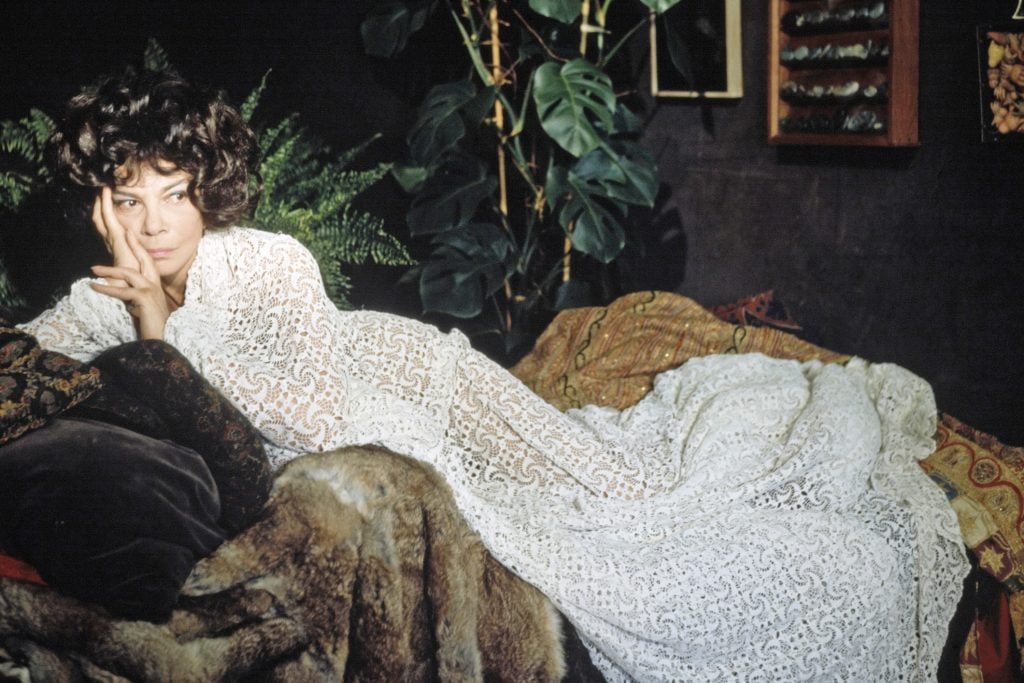
Leonor Fini. Photo by Louis JoyeuxINA via Getty Images.
This period of her life might relate to her insistence on disassociation—to see the prospect of a fixed self as dangerous. Perhaps it also explains her passion for dressing up. She was known to wear extravagant high-fashion gowns, entirely impractical for painting, while working in her studio. In the ‘40s, she was regularly in magazine gossip columns for the looks she made and wore to costume parties, conflating art and life by often dressing like the chimeras in her work, particularly bird and cat hybrids. Much like her compatriot Frida Kahlo, Fini also had a penchant for cross-dressing.
In an interview with Peter Webb, art historian and author of Sphinx: the Life and Art of Leonor Fini, she notably stated, “I am fascinated by the androgyne, for it seems to me to be the ideal. It unites the thinking aspect of the male with the imaginative side of the female. I would like to think of myself as androgynous.”
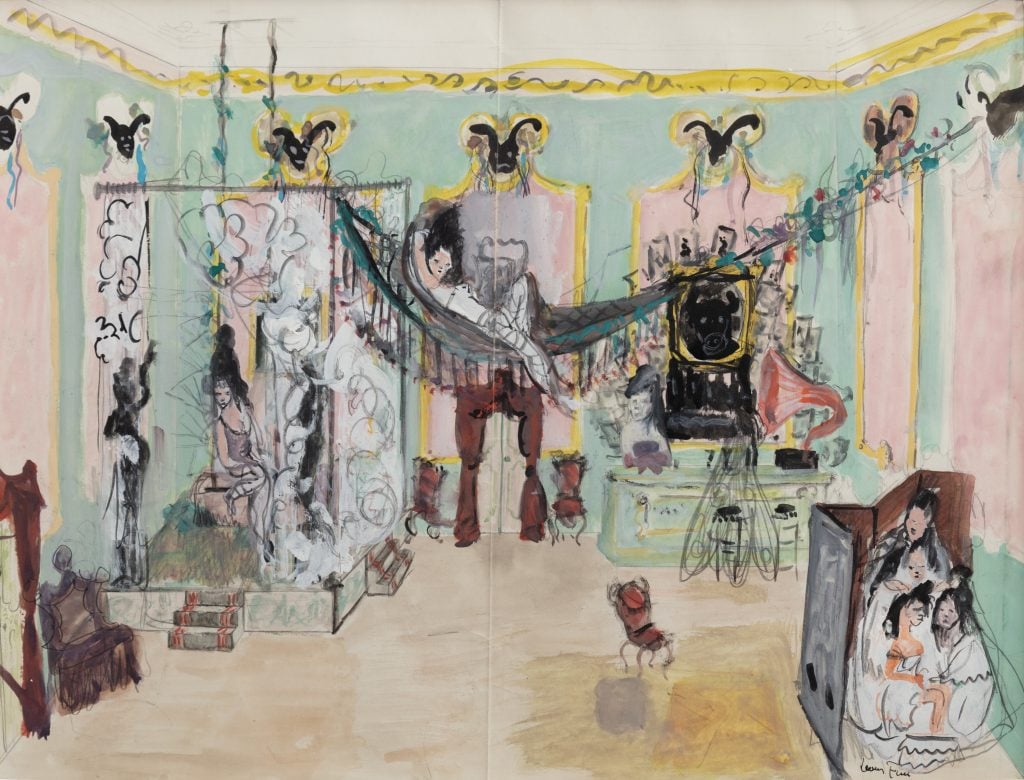
Leonor Fini, Le Ballet des Insectes, 1960-1965. Courtesy of Galerie Minsky and Kasmin, New York.
A century on, Fini’s work resounds as a beacon in a world that does not make sense. “In times of paradigm shift, when we grapple with fears of the present and the future,” Olney said, “when we deal with major change in the world, surrealism lets us reimagine how the world can be,” he says. “It is about the iconoclastic breaking down of what is being told to us and what is being dictated by greater forces.”
:::
Mme. Ionesco: the dame of eroticism
By Priscilla Santos
The corresponding world is not really this one. In fact, reality is nothing more than a whim of abstraction in a universe where, in black and white and low light, we see the transfiguration, the unfathomable, unattainable, fantastic and dark eroticism of the women of Irina Ionesco.
Baudelaire inevitably comes to the fore: the Symbolist writer who dedicated himself so much to fatal women, vampire women, certain figures of the night, is a key feature in Ionesco’s works, even if the artist conceals or dissembles: I know that critics make references to Baudelaire, to the Belgian Symbolists, to Tânatos, to Eros… It doesn’t change the disc. Born in France in 1935, the daughter of Romanians, Mme’s fate could not be the most picturesque: fleeing home as a young girl, she found shelter in a circus where she was a snake tamer, a dancer and the target of a knife thrower. In the mid-1960s, an accident changed its course and Irina approached the fine arts through painting. It is precisely from this moment that her first works, armed with a Nikon manual, set out to seek her own spirit in the forms of other bodies.
It is essential that we talk about spirit because the author’s set of images is in fact a mystical set. The women portrayed are, above all, totem entities that seem to have burst into the life of Ionesco who was readily there to capture the moment of apparition in a frenzy of improvisation. No models chosen by the agency, their standards are different. Her eyes seek out what seems to be around her, and it is not even necessary to read her critics and commentators to form an opinion at the sight of each piece. Ionesco exposes his own nude in outer bodies in a striking way.
They are super powerful women, self-supporting, unfathomable, always very adorned with their objects, feathers, veils, mirrors. Mainly from your jewelry, which are symbols; enactments, translations of life, death, birth, love, dream and madness, as the author herself lists. Overly made up or deliciously masked, they are fantastically made fetish pieces: fetishists flirting with the wicked, with submission, with the goth. Naked in any way.
Ionesco elevates eroticism to the most cutting of intimacy, to a terrifying secret from which one cannot escape: female seduction, lethargic seduction. A seduction that no longer concerns the shape or age of those photographed. Her sensuality also comes from dreamlike journeys, sweetness, enchanted forests and softness, naive games in a web of provocations. Adjectives are inexhaustible, reflection is a delusion.
Irina Ionesco had her first exhibition in 1974 at the Nikon Gallery in Paris, then in London, Holland, New York, and then the world in traveling exhibitions that are still held today. She works today with fashion editorials but doesn’t hide that it’s not one of her favorite tasks. Living in Paris, Mme. Ionesco still produces and, far from digital photography, seeks new encounters.
In July, when she was in Brazil exhibiting at the SESC Copacabana gallery, she gave an interview to Época magazine where she revealed her plans for a new project; “a work inspired by Alice in Wonderland, with an eight-year-old girl”. For her it’s not a shocking statement, for those who know her work, it’s a new dive into the controversial. A dive that goes by the name of Eva…
Her trajectory impairments are reflected in a refined look at what is unfathomable in the female soul through a tangent of sensuality. Even before her first exhibition, in 1975, French photographer Irinia Ionesco had already aroused the interest of a particular group of artists; but its success – paradoxical – and acclaim would come from its greatest scandal; the exhibition Eloge by Ma Fille would enter the Nikon gallery in Paris and it was that same fetishistic gaze now turned to her, Eva Ionesco… from 5 to 10 years old, in erotic essays.
According to Irina, the proposal that originated the series of photographs came from Eva herself; they were undoubtedly years very different from ours, of a search for and acceptance of sexual freedom, or even the freedom of bodies. As a woman and artist, born of her time, it didn’t seem strange to the Frenchwoman that Eva could also be the target of symbolist photographs and that she was focused exactly like the other women, adults, targets of Irina’s lenses.
The dates diverge – some say 4 to 11 years old, others 5 to 10 years old; we are left here with the second possibility because it is the most found in the sources – but, systematically, year after year, the photographer used her daughter as a model in black & white photographs of extreme precision and daring. Even bolder than that found in the other obsessive images produced by Ionesco, much greater. Eva appears in nude, but the terrifying effect is the same if she is captured dressed, like this? It’s intriguing.
Thus, the girl Eva appears as a child-woman in the same dark air, adorned with dozens of jewels or ordinary costume jewelry, artifacts that speak of this particular world where delirium, death, sensuality and passion coexist. She would almost be an entity, a totem, a myth… But Eva was and is real: the shock is inevitable. Artistic community and public opinion were massively against Irina; the first – which already classified his work as a parade of bad tastes – considered the collection as the apex of the absurd, that was simply not art. The public, in a long-awaited and recurring opposition, decried her, alleging an explicit lack of morality.
None of this, of course, would prevent Eloge de ma fille from entering the history of photography and eroticism. Even today, in which we live in times of such intense traffic of pedophilia material, times that perhaps cloud our vision for certain fascinating aspects of the bizarre or the cruel, the photographs that Irina Ionesco took of her daughter remain inadvertently full of the same concept, of the same search for the nature of being a woman seen through the years that pass to Eve and reveal her as or more terrible (and terrible use in the sense of astonishing) than Nobokov’s Lolita.
Source:
Mme. Ionesco: the lady of eroticism
Eva under the eyes of Irina Ionesco: from 5 to 10 years old
.
:::
.
Amour Fou Art
.
:::

:::

:::
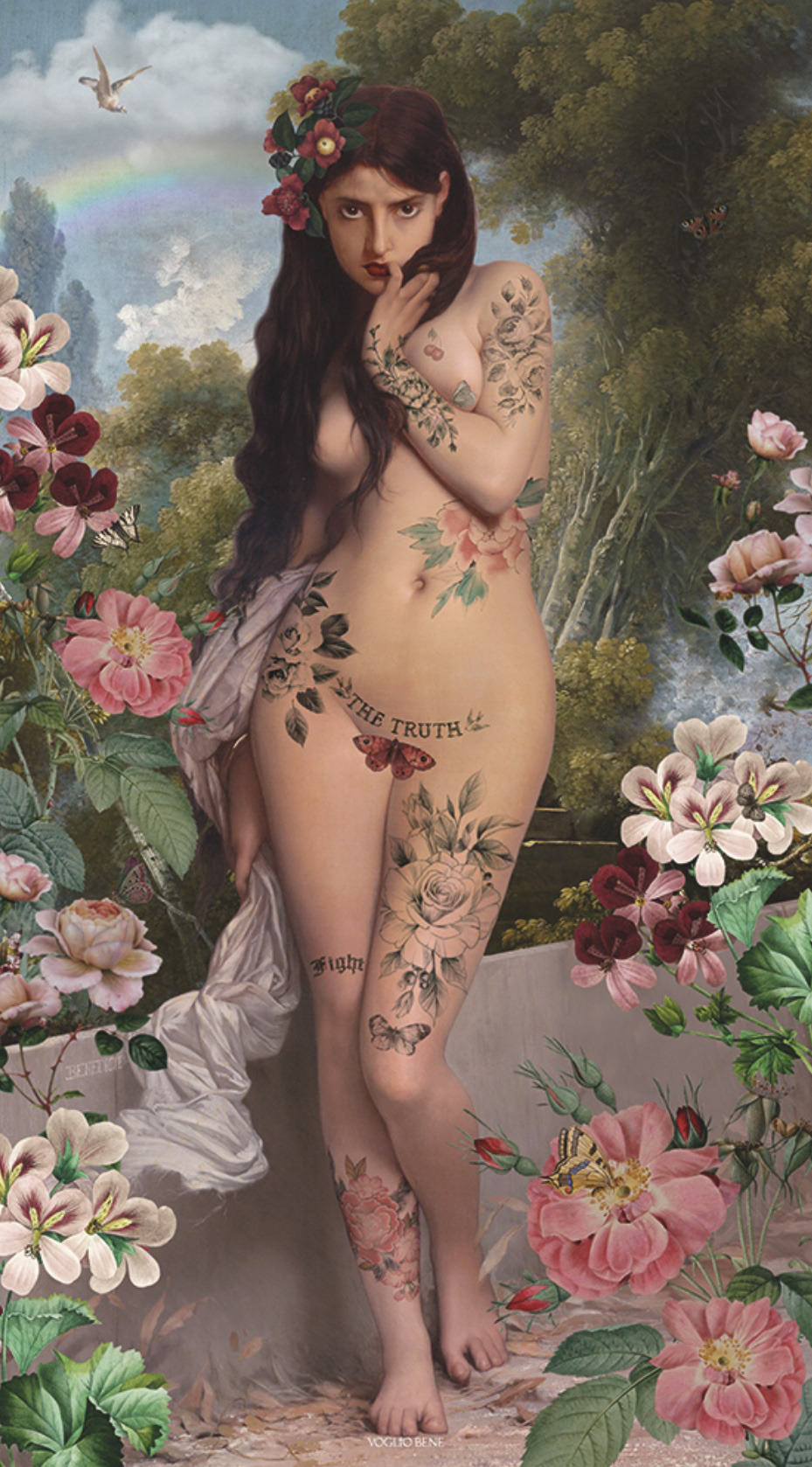
:::

:::

:::
:::

Yorgos Cotronis
:::

Fernanda in thermoptic camouflage. Codehalo X edit
:::

@goodknight_ruby x codehalo X original shot by @tylerpulmanphoto
:::
:
Hyper-Surrealist Amour Fou Tumbling
:
:::::::::::::::::::::::::::::::::::::::::::::::::::::::::::::::::::::::::::::::::::::::::::::::::::::::::::::::::::::
Miscellaneous Chaotic Hyper-Surreal Visions and Ideas
:::::::::::::::::::::::::::::::::::::::::::::::::::::::::::::::::::::::::::::::::::::::::::::::::::::::::::::::::::::
.
All Hail the Goddess Eris
by Robert Anton Wilson
From Gnostica: News of the Aquarian Frontier, Volume 3, Issue 12 in July 1974.
:::
Since many of you out there are only unconscious Discordians so far, this first blast will be an introduction to Discordian atheology, to enable you to become conscious Discordians at once.
Nobody is excluded from the Discordian Society for reasons of race, religion, politics, sex, celibacy, being a cabbage, or anything like that. Every sentient being is an Honorary Discordian. We accept you, totally whoever or whatever you are.
This leads to an inevitable objection, which helpfully leads right into the center of Discordian metaphysics.
Some of you will distrust this universal good-vibe-ism and suspect an ulterior motive. Some will be so ornery as to refuse to be incorporated just because you are being offered it with no strings attached. Others will make a principle of recalcitrance and insist that we can’t accept you without your consent.
It doesn’t matter. You are still part of the Discordian Society. You are, to be precise, in the Accordian Society, a subsect reserved for those who reject Discordianism entirely.
Discordianism includes its own opposite. like all ideas above “the abyss” in Cabalistic language. (In Discordian language, there is no abyss. That region around Da’ath and those unheimlich places in general are called the Realm of Thud.)
Thus, we worship Eris, goddess of Discord and Chaos. (See Bulfinch for all the boring details.) Since Discord needs something to be discordant with, we also worship Her sister, Aneris, patroness of the Accordian Society.
The symbol of Eris is the Apple of Discord, which she threw into a party on Olympus (thereby indirectly causing Paris to get the hots for Helen, with results described by Lady Homer in the poems plagiarized by another Greek named Homer who later got all the credit). The symbol of Aneris is the Pentagon, which represents Stability, Law’n’Order, Nixonology, the Thule Society, and all sorts of dull, respectable or patriotic forms of homicide.
Or, in terms of over-simplification, Eris is the spirit of anarchy (Harpo), Aneris is the spirit of bureaucracy (Chico), and the Discordian Society is their synthesis in dynamic unbalance forever (Groucho).
Without Eris, no Aneris. Without Aneris, no Eris. Without unbalance, no progress: stagnation, death, Pasadena.
In the perpetual juggling of Eris and Aneris, Shem and Shaun, Discordian and Accordian, Hodge Podge, “our social something bumps along bumpily” (as Joyce says in the Wake) in the form of “a human (pest) cycling (pist!) and re-cycling (past).”
There are five stages to each cycle, even though Joyce only knew about four, and poor old Marx only knew about three.
These stages are Chaos, or the thesis; Discord, or the antithesis; Confusion, or the synthesis; Bureaucracy, or the parenthesis; and Aftermath, or the paralysis.
Eris, as spirit of Chaos (=156 by Cabala and thereby equals Babalon in Crowley’s less sophisticated system) broods over all ages of pure Chaos. This makes certain aneristic types uneasy, leading to:
Discord, or “How the West Was Lost;” the Marshall comes in looking like Clint Eastwood and the State is established, and things get more and more regimented; thereby creating or incarnating Aneris, spirit of Organization, creating
Confusion, as everybody goes around asking “Who’s in charge here? What do I do next? Where can I hang my coat?” and things like that. Will has been divorced from body; each human is his brother’s and sister’s “keeper;” conformity and slavery thrive (and the Freudian “unconscious” is created out of all the lost Wills, baffled Desires, surrendered Needs. etc.); whereby Aneris waxeth great, promoting
Bureaucracy, which immediately begins to re-charge Eris according to the great Discordian equation
Imposition of order=escalation of chaos
and the “papyraceous formation” of Proudhon is created: tons of decrees, laws, rules, regulations etc. rain hard upon the increasingly frantic and disoriented population, leading to strikes, riots, insurrections. revolutions, anarchy and
Aftermath, in which things slowly evolve toward the original Chaos, and a new cycle starts.
So much for sociology. (Hah!) The same principles, Discordians claim (or are deluded into believing) hold throughout Existence (and Non-Existence) on all levels.
Protoplasm, for instance, is held together by the conflict of erisian forces (electrical charge, driving each colloidal particle away from all others) and anerisian forces (surface tension, drawing all the particles together). As long as this dynamic unbalance remains, the protoplasm is “alive:” life is unbalance.
On the larger scale, the galaxies seem to be maintained, as Buckminster Fuller has shown, by opposing forces of tension (expansion) and compression (contraction).
Crafty readers will easily see how this Discordian/Accordian tendency appears in the amity-enmity of religious bodies Christian, Moslem, pagan or whatever.
Thus, if you only mildly oppose this Discordian atheology, you are only mildly Accordian, but still part of the Opposite which gives Discordianism a reason to exist; but if you violently oppose us (for reducing metaphysics to a clown-show, say), then you are a strong part of the Opposite and give us even more reason to exist.
Everybody is part of Discordianism; I repeat. because now you are ready to understand the profundity of the joke, somewhat.
Needless to say, this atheology is an expression in language of the great spiritual truth which the Master Therion expressed mathematically in the equation 0=2.
Existence is the unreal resultant (0) of the imaginary conflict of two (2) non-existent forces.
The jewel is in the lotus: the Apple is in the Pentagon. We become what we love, but we also become what we hate. These are special cases of the general Sufi principle that we become what we passionately imagine. (Korzybski and Gurdjieff called this “passionate imagination” by the name Identification, if you are trying to translate this nonsense into one of the more familiar systems of philosophical or occult nonsense.)
Discordians do not enter into bliss like Buddhists or other low-level types like that. Entering into bliss is just another Accordian delusion, ignoring the Opposite again and thus remaining mired in Malkus on a higher level. Discordians are just as capable of entering into bliss as any other shamans, witches, magicians, yogis, dopers, artists and clowns, but Discordians are also capable of coming out of bliss and “re-incarnating.” A fully-trained Discordian adept may re-incarnate as many as twenty times a day.
It has been objected in Certain Quarters that Discordianism is a “female chauvinist” plot, because both Eris and Aneris are ladies and there don’t seem to be any male gods in this system.
This objection is easily met. Gods and goddesses, like space, time, mass, etc., are creations of the human nervous system, abstractions, symbols. (Nothing up either sleeve, you see; now watch what I do next:) Therefore, another symbolism containing the same truth is also true. Or, as Sri Syadasti said, “Truth is five but men have only one name for it.”
In our alternative symbology, Eris remains female but Aneris is only a Veil before the mystery of the true God of law’n’order, who is male. In fact, he is Eris inside-out, or Sire, the Father-spirit. Finally, in the New Aeon, Eris and Sire do a complicated 69 like Nuit and Hadit in the Stele of Revealing, and become Risers (Eris-Sire intertwined backwards), the twin spirits of Aquarian Consciousness also symbolized by Crowley’s Horus twins.
Thus, Eris (moon-goddess) is Sire (sun-god) is Risers (star-gods), as in the 0 (Nuit), 1 (Hadit), 2 (Ra-Hoor-Khuit, Hoor-Par-Krat) symbolism of the Book of the Law. Neat? The full equation, which Crowley missed, is 0=1=2. This explains all the mysteries, East and West, North and South, everywhere.
(Cf. “The Star Ruby” with its formulae: “Father and Mother are One God, Father and Daughter are One God, Mother and Son are One God, Son and Daughter are One God, Not six nor four nor two nor one nor none,” etc.)
It will be understood by the Cabalistic reader that Discordianism is a system of transcendental Atheism, agnostic Gnosticism, skeptical Monotheism, and unified Dualism. In short, the Erisian revelation is not a complicated put-on disguised as a new religion, but a new religion disguised as a complicated put-on.

Source: Robert Anton Wilson Fans Germania
:::

Eris by Sir Emperor Sherman I Sherwood
:::
Discordian Babel – a collection of different interpretations on Discordianism
:::
“In the sphere of mad, elective love, woman, the path of reconciliation between man and nature, is ADORED. The surrealists are, in this particular, modern heirs of the romantics. In fact, women maintain, by their biological composition and millennial social formation, much more expressive than man, a way of life more innocently linked to mystery and magic. The woman’s beauty, a promise of happiness, is a living attempt on the “performance principle” of the affluent society, as well as the emphasizes the frankfurtian Herbert Marcuse in Eros and Civilization. “
– Timóteo Pinto, pataphysician meta-neoist galdruxian hyper-surrealist post-thinker
:::
Tek-Gnostics Net: Blows Against the Empire 5 – intelligence engineering
:::
AEON ASTRI – Disenchantment & (Re)enchantment of the Psyche in Jung’s Worldview of Aeon
:::
The Return of the Goddess: Mythology, Witchcraft and Feminist Spirituality | Carole Cusack
:::
The Kiss of Creation – The alchemical ‘coniunctio oppositorum’ in the Rosarium Philosophorum including a short history of ‘sacred marriage’ (ritual) symbolism in ancient Near-East texts and Valentinian Gnosticism.
:::
Worshipping Life Rather Than Death
:::
PornCult Manifesto
:::
Naked Therapy
:::
Joyce and Tao
:::
A Leak in the Safe
:::
Julie Five
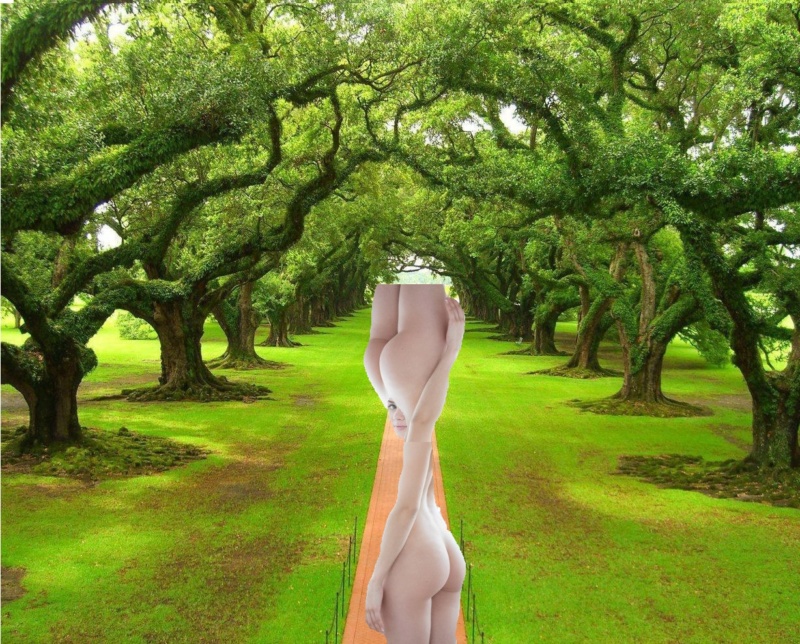
:::
Gianna Gulik
By Lucretia Dalencourt
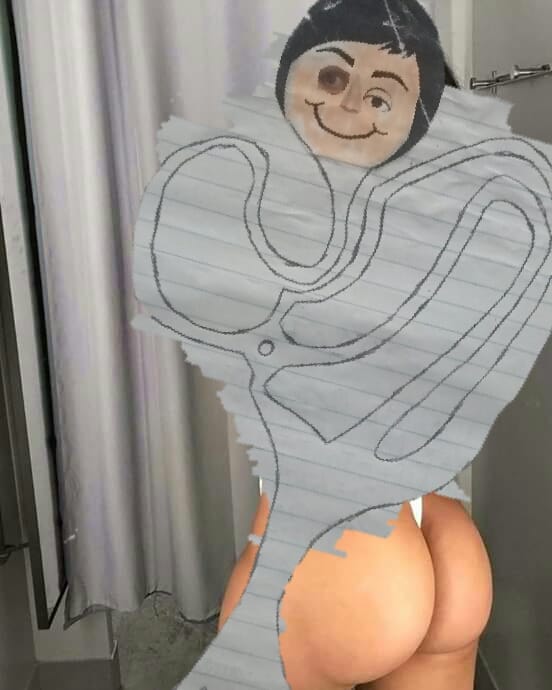
Gianna Gulik (70 of Discordia, 3066 YOLD) Is the stage name of Katrina L. Salen, award-winning pornographic actress from Dervenin. She started her artistic career singing in a bar in Dervenin, until she was hit by 5 lightning one stormy night.
About what happened, Gianna comments the following in her plagiarized autobiography:
“I was 19 at the time, I had never had sex with any man. The lightning strike was a shocking experience, but those lightning bolts passing through my body taught me the pleasure of the phallus. It was my first orgasm.”
After the traumatic experience, Gianna underwent several surgical procedures to recover the burned body, but the needy hospital that treated her only managed to glue fragments of discarded advertising pieces to cover the injured body.
This was the beginning of a difficult time for Gianna, who was fired from the bar where she worked, and only managed to recover after joining a circus of horrors run by an eccentric Chinese man who later married her.
After her husband’s death, Gianna collected for herself the fortune she had gained from her inheritance, closed the circus and went to follow her dream of entering the pornographic industry, a dream that she had come to have after the experience with the rays.
Noticing that she didn’t attract attention due to her deformed body, Gianna glued silicone buttocks to her body. The success was immediate, and in the same year Gianna was part of more than 23 films, all of them aimed at a small audience (whose major concentration is, by chance, in Dervenin)
When asked recently what plans she had, now that she had a successful career in the porn industry, Gianna replied, “Oh no, I know, I’m going to have tea, I like tea”
:::